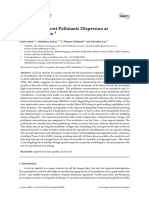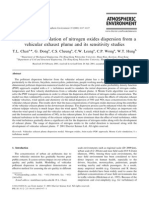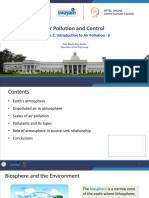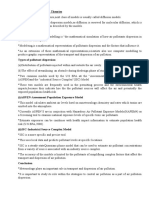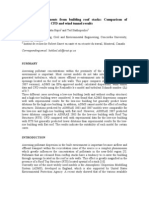Modelling Urban Pollution Dispersion by Using MISKAM
Modelling Urban Pollution Dispersion by Using MISKAM
Uploaded by
Márton BalczóCopyright:
Available Formats
Modelling Urban Pollution Dispersion by Using MISKAM
Modelling Urban Pollution Dispersion by Using MISKAM
Uploaded by
Márton BalczóOriginal Title
Copyright
Available Formats
Share this document
Did you find this document useful?
Is this content inappropriate?
Copyright:
Available Formats
Modelling Urban Pollution Dispersion by Using MISKAM
Modelling Urban Pollution Dispersion by Using MISKAM
Uploaded by
Márton BalczóCopyright:
Available Formats
Modelling urban pollution dispersion by using MISKAM
Mrton Balcz 1, Tams Farag2, Tams Lajos3 PhD Student1, Student2, Professor3 Budapest University of Technology and Economics, Department of Fluid Mechanics ABSTRACT The micro-scale flow and dispersion model MISKAM is a CFD code for the prediction of pollutant dispersion in built urban environment. In this paper the application of MISKAM is shown on the example of the Millennium City Centre project in Budapest. Simulations for two building configurations and five main wind directions were performed to predict the change of the annual mean concentration level in the investigated area as consequence of construction of the city centre. Comparison of results to earlier wind tunnel data helps to check the accuracy and reliability of MISKAM code in practical application. INTRODUCTION Urban air pollution caused by car traffic is getting one of the most important environmental problems in cities. To determine the wind field and the concentration distribution in urban microscale areas (length scale up to 5 km) use of obstacle resolving methods are necessary. Traditional solution is the physical modelling in wind tunnels, but also numerical simulation (CFD) can be used for this purpose. Although current advanced CFD simulations use sophisticated tools like unsteady flow with LES to understand and describe pollution dispersion mechanisms better, their use needs deep knowledge in fluid mechanics, and costs much time. Different requirements at the environmental regulatory side (e.g. large amount of modelled buildings, fast model preparation, limited simulation time and computer capacity) make simpler methods necessary, at the expense of more limited accuracy. The microscale flow and dispersion model MISKAM fulfils the mentioned requirements [1]. About MISKAM MISKAM (Microscale Flow and Dispersion Model) was developed by Dr. J. Eichhorn, University of Mainz, Germany, for urban pollutant dispersion simulations. Engineering Bureau Lohmeyer, Karlsruhe developed the user interface WinMISKAM. MISKAM was evaluated according VDI 3783 Part 9 Environmental Meteorology Prognostic microscale wind field models Evaluation for flow around buildings and obstacles [2], and it is in regulatory use at environmental agencies, consulting organisations, experts etc. in Germany and France. (Due to the predefined boundary conditions and other parameters its use requires only basic knowledge in fluid mechanics.) MISKAM solves the Reynolds averaged Navier-Stokes equation with a modified k turbulence closure in a non-uniform Cartesian grid for the flow field, and it calculates the concentration of transported passive scalars using the Eulerian
dispersion equation. The modelled area can not contain steep relief. Buildings are modelled with blocks. Thermal effects, buoyancy and chemical reactions cannot be modelled. Pollution sources are volume sources. MISKAM can simulate neutral and stable atmospheric conditions (vertical temperature gradient -6.48 K/km, and -10 - -6.48 K/km, respectively). In second case, the turbulence mixture factor Km is set lower than in the first case. MISKAM uses upwind numerical scheme. The high numerical diffusion of this scheme is partly compensated at the dispersion with Smolarkiewicz correction steps. The Millennium City Centre project In the southern part of Budapest, on the riverside of the Danube, the construction of a group of tall buildings has been planned (Fig. 1.). Significant change of the pollution level was supposed in the neighbouring district due to the 20% growth of individual traffic induced by the City Centre decreased ventilation caused by the new buildings areas very busy main street, bounded by buildings from one side becomes a street canyon. Wind tunnel and numerical investigations carried out by the Department of Fluid Mechanics of BUTE in 2002 [3,4] gave a prediction on the pollution level and ventilation in the Millennium City Centre and its environment. For numerical simulation FLUENT and the above mentioned MISKAM (v4.22) was used. Recently, further MISKAM simulations have been carried out using denser grid and other refinements of the modelling, the results of which are shown in this paper.
Fig. 1. The investigated area of Budapest with line sources indicated by row of dots and measurement points
DESCRIPTION OF THE NUMERICAL MODEL Computational domain and boundary conditions The size of the model domain is 1250 m 1660 m 140 m (domain height is about 4 times average building height). The grid includes 195 260 40 = 2.028 million cells (Fig. 2.). Neutral atmosphere is supposed. Wind speed is set to 3.1 m/s at 25m height. MISKAM generates a logarithmic atmospheric boundary layer profile from this data. The other boundaries are also predefined by MISKAM like outlet: outflow, ground and building surface: friction with roughness lengths, top: symmetrical. Source strengths were taken from vehicle emission and traffic data. Totally 10 cases were simulated: 5 wind directions (22.5, 90, 213.75, 270, 326.25 degree to N) and two configurations: without and with City Centre. Computational time for one case was about 12 hours on a 2.4GHz PC.
Fig. 2. Computational domain and mesh RESULTS Wind field and concentration distribution maps Calculated data were visualised using Tecplot. Known flow and dispersion effects like street canyon vortices, street channel flows, clean air jets between buildings can be observed. One example of the calculated flow fields with City Centre, wind direction W is shown in Fig. 3. Comparison with wind tunnel data Comparison of the experimental and CFD results is based on the dimensionless concentration c which must be similar in both cases according [5]:
clean air jets Street canyon vortex
Fig. 3. Pollution distribution in 1.65 m height at wind direction W, with City Centre a) top view, b) detailed view with flow in a cross section of the street canyon
C u ref H C u ref H = c = , c = Q L Q L Simulation Wind tunnel
where C [kg/m3] concentration, H [m] building height, uref [m/s] wind velocity at building height, and Q/L [kg/s/m] line source strength. Fig. 4 shows typical distributions of measured and calculated dimensionless concentration as function of wind direction without and with City Centre in few measurement points at two different meshes. Points R1, R5 and U8 are situated near the line sources, U2 is far from them (see Fig. 1.). Although at some wind directions large differences between calculated and measured values can be observed, in majority of cases the agreement is acceptable. Grid dependency (difference between the results from the earlier and current MISKAM mesh) is low, except in some near-source points like U8 and R1. Comparison of annual mean concentration ( c ) in all 24 measurement points, determined from measured and calculated values by the equation:
c
annual
= c p i i
i =1
is shown in Fig. 5. p i is wind direction probability. In points R2 and R3 strong disagreement can be observed. These points are very close to line source (see Fig. 1.). Excluding these two points, the correlation factor is R 2 = 0.97 without City Centre and R 2 = 0.79 with City Centre. Last worse correlation can partly be explained by differences in geometries of wind tunnel and MISKAM models of the planned buildings. By all means the positive effect of the annual averaging on the correlation factor should be considered.
Fig. 4. Calculated and measured concentration as function of wind direction without and with City Centre in points R1, R5, U2, U8
Fig. 5. Correlation of experimental and numerical data (annual mean values) without and with City Centre
CONCLUSIONS Use of MISKAM code provides detailed flow and concentration fields so it helps to understand flow and dispersion phenomena in urban area. Comparison of calculated concentrations to wind tunnel data shows in most cases acceptable agreements, but in few points also significant differences at some wind directions. At near-source points grid dependency and higher error was observed. Far source points agree better, and the results are more grid independent. More accurate modelling of pollution caused by near sources would be necessary. It is supposed that in the deviation of calculated and measured concentrations the difference between modelling of line sources in wind tunnel and in numerical simulation has significant effect. MISKAM is suitable for application in environmental regulatory field. ACKNOWLEDGEMENTS Authors acknowledge the support of OTKA (T 037651, T 037730) and wish to thank the Clean Air Action Group, Budapest for their financial support at the licensing of WinMISKAM. REFERENCES
[1] EICHHORN, J.: MISKAM - Handbuch zu Version 4, Wackernheim, 2003, available for download from http://www.lohmeyer.de [2] EICHHORN, J.: Appllication of a new evaluation guidelinie for microscale flow models 9th Int. Conf. on Harmonisation within Atmospheric Dispersion Modelling for Regulatory Purposes Garmisch-Partenkirchen, June 1-4. 2004 available for download from http://www.harmo.org
[3] GORICSN, I. BALCZ, M., RGERT, T., SUDA, J.M.: Comparison of Wind Tunnel Measurement and Numerical Simulation of Dispersion of Pollutants in Urban Environment Proc. of Int. Conference on Urban Wind Engineering and Building Aerodynamics Impact of Wind and Storm on City Life and Built Environment, Von Karman Institute for Fluid Dynamics, Belgium, 2004, pp.D.6.1-10. [4] LAJOS, T., SZEPESI, ZS., GORICSN, I., RGERT, T., SUDA, J.M., BALCZ, M., Wind Tunnel Measurement and Numerical Simulation of Dispersion of Pollutants in Urban Environment, Proc. of Conference on Modelling Fluid Flow (CMFF03) 2003, Vol.I. pp.507-514. [5] VDI guideline VDI 3783 Part 12: Environmental meteorology - Physical modelling of flow and dispersion processes in the atmospheric boundary layer - Application of wind tunnels Kommission Reinhaltung der Luft (KRdL) im VDI und DIN Normenausschuss, 2000.
You might also like
- Hearing Officer's ReportDocument34 pagesHearing Officer's ReportNew Mexico Political ReportNo ratings yet
- Mine Ventilation Using CFDDocument5 pagesMine Ventilation Using CFDmitevNo ratings yet
- Calculation of Design Tunnel VentilationDocument14 pagesCalculation of Design Tunnel Ventilationpalindapc100% (3)
- Atmospheric Stability Classes Rev 1 PDFDocument33 pagesAtmospheric Stability Classes Rev 1 PDFDJSeidel100% (1)
- ProofsDocument41 pagesProofsMuller Gabriel da Silva ChavesNo ratings yet
- FO717 E84 F1 B81.editedDocument8 pagesFO717 E84 F1 B81.editedWilly MwangiNo ratings yet
- A Cylindrical CFD Tunnel ApproachDocument11 pagesA Cylindrical CFD Tunnel ApproachNermine Abdel GelilNo ratings yet
- Active Reduction of Air Pollutant Concentrations at An Urban SquareDocument4 pagesActive Reduction of Air Pollutant Concentrations at An Urban SquareMárton BalczóNo ratings yet
- Numerical Modelling of Turbomachinery Aero-And ThermodynamicsDocument3 pagesNumerical Modelling of Turbomachinery Aero-And Thermodynamicsquami3quartsNo ratings yet
- Using CFD Capabilities of CONTAM 3.0 For Simulating Airflow and Contaminant Transport in and Around BuildingsDocument18 pagesUsing CFD Capabilities of CONTAM 3.0 For Simulating Airflow and Contaminant Transport in and Around BuildingscliveNo ratings yet
- Recommendations On The Use of CFD in Predicting Pedestrian Wind EnvironmentDocument4 pagesRecommendations On The Use of CFD in Predicting Pedestrian Wind EnvironmentHelen ChoiNo ratings yet
- Applsci 13 07408 v2Document20 pagesApplsci 13 07408 v2wilmersilvaramirezNo ratings yet
- Journal of Natural Gas Science and Engineering: Jinyu An, Shini PengDocument9 pagesJournal of Natural Gas Science and Engineering: Jinyu An, Shini PengronnyNo ratings yet
- 3D Modeling of Urban Areas For Built Environment CFD Applications Using ComsolDocument7 pages3D Modeling of Urban Areas For Built Environment CFD Applications Using ComsolsreejuslNo ratings yet
- Atmospheric Environment: Parra M.A., Santiago J.L., Martín F., Martilli A., Santamaría J.MDocument9 pagesAtmospheric Environment: Parra M.A., Santiago J.L., Martín F., Martilli A., Santamaría J.MJanos KovacsNo ratings yet
- 2251 6832 4 43 PDFDocument14 pages2251 6832 4 43 PDFhola123456789jgNo ratings yet
- Winkelmann2022 Michelstadt KalWin Report Validation Okt2022Document13 pagesWinkelmann2022 Michelstadt KalWin Report Validation Okt2022baz1ngaNo ratings yet
- Windturret TestDocument27 pagesWindturret TestTim KingNo ratings yet
- UrbaWind, A Computational Fluid Dynamics Tool To Predict Wind Resource in Urban AreaDocument9 pagesUrbaWind, A Computational Fluid Dynamics Tool To Predict Wind Resource in Urban AreaMeteodyn_UrbawindNo ratings yet
- Modelling Urban Traffic Air Pollution DispersionDocument6 pagesModelling Urban Traffic Air Pollution DispersionHAMZA ISKSIOUINo ratings yet
- Sustainability 07 09088Document12 pagesSustainability 07 09088basarkNo ratings yet
- Yongfeng Qu, Maya Milliez, Luc Musson-Genon and Bertrand CarissimoDocument5 pagesYongfeng Qu, Maya Milliez, Luc Musson-Genon and Bertrand CarissimoHakim AliNo ratings yet
- Assessment of Building Air Quality in Respect of Eight Different Urban Block Designs Based On CFD SimulationsDocument20 pagesAssessment of Building Air Quality in Respect of Eight Different Urban Block Designs Based On CFD Simulationsmarvellous oseNo ratings yet
- Combinaçao de Aplicaçao de Aerofotgrametria - Laser Scaning e Segmentaçao DinamicaDocument8 pagesCombinaçao de Aplicaçao de Aerofotgrametria - Laser Scaning e Segmentaçao DinamicaRicardo Guedes da SilvaNo ratings yet
- Urban Canopy ModelDocument24 pagesUrban Canopy ModelShefali VermaNo ratings yet
- Refined MISKAM Simulations of The Mock Urban Setting TestDocument6 pagesRefined MISKAM Simulations of The Mock Urban Setting TestMárton BalczóNo ratings yet
- Aerospace: Modelling Airport Pollutants Dispersion at High ResolutionDocument10 pagesAerospace: Modelling Airport Pollutants Dispersion at High ResolutionIjaz FazilNo ratings yet
- Comparison of ResourceDocument11 pagesComparison of ResourceVelmurugan KNo ratings yet
- Optimal Design of Gas Distribution Network: A Case Study: September 2011Document18 pagesOptimal Design of Gas Distribution Network: A Case Study: September 2011Nikhil SainiNo ratings yet
- Prini CipalDocument9 pagesPrini CipalcaciedNo ratings yet
- Case Study For The Amsterdam ArenA StadiumDocument24 pagesCase Study For The Amsterdam ArenA StadiumAnonymous ARMtmNKLNo ratings yet
- Use of Computational Fluid Dynamics in Civil EngineeringDocument14 pagesUse of Computational Fluid Dynamics in Civil EngineeringAnonymous TqP3LLNuuNo ratings yet
- Computational Fluid Dynamic Modeling For Hazardous Gas Dispersion Analysis in Deepwater, BrazilDocument11 pagesComputational Fluid Dynamic Modeling For Hazardous Gas Dispersion Analysis in Deepwater, BrazilRenato CarvalhoNo ratings yet
- Urban Micro ClimateDocument3 pagesUrban Micro ClimateAlexandra S. ȚăranuNo ratings yet
- Was 2204006Document22 pagesWas 2204006ashraf.hameedNo ratings yet
- Ijmet: ©iaemeDocument8 pagesIjmet: ©iaemeIAEME PublicationNo ratings yet
- Transfer Chutes Predicting Dust Emissions by Multiphase CFD and Coupled DEMCFD SimulationsDocument22 pagesTransfer Chutes Predicting Dust Emissions by Multiphase CFD and Coupled DEMCFD SimulationsSeyit AvcuNo ratings yet
- CFD Monte Carlo Simulation of Nitrogen Oxides Dispersion From A Vehicular Exhaust Plume and Its Sensitivity Studies PDFDocument11 pagesCFD Monte Carlo Simulation of Nitrogen Oxides Dispersion From A Vehicular Exhaust Plume and Its Sensitivity Studies PDFmojicapNo ratings yet
- FM Report PDFDocument9 pagesFM Report PDFTanmay AmbulkarNo ratings yet
- Analysis of Jet Fan Ventilation System Installed IDocument12 pagesAnalysis of Jet Fan Ventilation System Installed IRobert CurculescuNo ratings yet
- MatlabDocument13 pagesMatlabDerek JohnsonNo ratings yet
- Aeroacoustics Simulation of An Automotive A-Pillar Rain GutterDocument12 pagesAeroacoustics Simulation of An Automotive A-Pillar Rain GutterJose David Duque MedinaNo ratings yet
- 2013 - Artigo - Closed Form Solutions To Water Pollution ProblemsDocument7 pages2013 - Artigo - Closed Form Solutions To Water Pollution ProblemsAndré Luis SilveiraNo ratings yet
- PKU Week 13Document93 pagesPKU Week 13Dimas TaufiqNo ratings yet
- Modelling The Management of Street Surface Sediments in Urban RunoffDocument8 pagesModelling The Management of Street Surface Sediments in Urban Runoffroday100No ratings yet
- CFD Simulation of Cross-Ventilation For A Generic IsolatedDocument14 pagesCFD Simulation of Cross-Ventilation For A Generic IsolatedMohamad HashemNo ratings yet
- Archive of SIDDocument14 pagesArchive of SIDOSCARIEMNo ratings yet
- Applied Sciences: A Comparative Analysis For Air Quality Estimation From Traffic and Meteorological DataDocument20 pagesApplied Sciences: A Comparative Analysis For Air Quality Estimation From Traffic and Meteorological DataLucica BarbesNo ratings yet
- Numerical Evaluation of Pollutant Dispersion in The Built Environment: Comparisons Between Models and ExperimentsDocument12 pagesNumerical Evaluation of Pollutant Dispersion in The Built Environment: Comparisons Between Models and ExperimentsJoan DivesNo ratings yet
- Numerical Flow Simulation Using Star CCM+Document9 pagesNumerical Flow Simulation Using Star CCM+Alexander DeckerNo ratings yet
- D16 - Cost Analysis, Literature Data (Incl. Pilot Plant Trials Conducted by Partners)Document23 pagesD16 - Cost Analysis, Literature Data (Incl. Pilot Plant Trials Conducted by Partners)rasheed_tech2012No ratings yet
- Paper 39-Neural Network Supported Chemiresistor Array SystemDocument6 pagesPaper 39-Neural Network Supported Chemiresistor Array SystemDina And OmarNo ratings yet
- Keck-Sick2008 Article ThirtyYearsOfNumericalFlowSimu PDFDocument19 pagesKeck-Sick2008 Article ThirtyYearsOfNumericalFlowSimu PDFSalman BoghaniNo ratings yet
- 2021 Mmwave On The Road Best For SimulationDocument8 pages2021 Mmwave On The Road Best For SimulationAmjedNo ratings yet
- A Modelling System For Predicting Urban Air PollutDocument12 pagesA Modelling System For Predicting Urban Air PollutAleks Guevara PalaciosNo ratings yet
- Applying Fixed Box Model To Predict The Concentrations of (PM10) in A Part of Al-Kut City, Wasit Province (Iraq)Document12 pagesApplying Fixed Box Model To Predict The Concentrations of (PM10) in A Part of Al-Kut City, Wasit Province (Iraq)IAEME PublicationNo ratings yet
- Atmosphere 10 00683Document30 pagesAtmosphere 10 00683Vânia Raposo de MouraNo ratings yet
- The Impact of Urban Street Layout On Local Atmospheric EnvironmentDocument12 pagesThe Impact of Urban Street Layout On Local Atmospheric EnvironmentJanos KovacsNo ratings yet
- Design Exercise CT5550Document16 pagesDesign Exercise CT5550Hashem EL-MaRimeyNo ratings yet
- Green Communications: Principles, Concepts and PracticeFrom EverandGreen Communications: Principles, Concepts and PracticeKonstantinos SamdanisNo ratings yet
- Toxic Release and Dispersion ModelDocument49 pagesToxic Release and Dispersion ModelAin SyuhadaNo ratings yet
- Gaussian Plume ModelDocument19 pagesGaussian Plume ModelDhananjay ShimpiNo ratings yet
- L2 - BRG - Introduction To Air Pollution - IIDocument37 pagesL2 - BRG - Introduction To Air Pollution - IIneetuNo ratings yet
- Dat 2017Document12 pagesDat 2017Samir SaadNo ratings yet
- 4.atmospheric Diffusion TheoriesDocument6 pages4.atmospheric Diffusion TheoriesJohn BerkmansNo ratings yet
- Plume DispersionDocument16 pagesPlume DispersionVesko IlijaziNo ratings yet
- Air Pollution Dispersion Modelling 23MCM01Document10 pagesAir Pollution Dispersion Modelling 23MCM01vysakhpradeep99No ratings yet
- Free Memo TemplateDocument12 pagesFree Memo TemplateKhalidNo ratings yet
- Air Pollution 2Document98 pagesAir Pollution 2KUSHAGRA SRIVASTAVANo ratings yet
- M.E Environmental Engineering R18Document62 pagesM.E Environmental Engineering R18MangoNo ratings yet
- Report SG Kim Kim - EnglishDocument50 pagesReport SG Kim Kim - EnglishAhmad HarisNo ratings yet
- Validation of PHAST Dispersion ModelDocument6 pagesValidation of PHAST Dispersion ModelAshwini NikamNo ratings yet
- Aermod Online Training BrochureDocument5 pagesAermod Online Training BrochureJeimmy LopezNo ratings yet
- CE8005-Air Pollution and Control Engineering QP - by WWW - Learnengineering.inDocument14 pagesCE8005-Air Pollution and Control Engineering QP - by WWW - Learnengineering.inRaghuramNo ratings yet
- Air-Pollution-Meteorology UNIT IIDocument91 pagesAir-Pollution-Meteorology UNIT IIDR. Ramesh ChandragiriNo ratings yet
- Air Pollutants Transport ModelsDocument12 pagesAir Pollutants Transport ModelsRahul DandautiyaNo ratings yet
- Unit 2 MeteorologyDocument29 pagesUnit 2 Meteorologypthangarasu sctengNo ratings yet
- Air Pollution Examples: Air Quality and MeteorologyDocument6 pagesAir Pollution Examples: Air Quality and MeteorologyHannah PascuaNo ratings yet
- Topic 9 - Air PollutionDocument36 pagesTopic 9 - Air PollutionYousef ZamNo ratings yet
- CALPUFF v7 UserGuide AddendumDocument67 pagesCALPUFF v7 UserGuide AddendumnimaaandmNo ratings yet
- Stack Height Determination: Hamriyah IPP Sharjah UAEDocument31 pagesStack Height Determination: Hamriyah IPP Sharjah UAEFAREEDNo ratings yet
- Air Quality ModellingDocument27 pagesAir Quality ModellingSubhamoy GhoshNo ratings yet
- MODELLING OPEN FLARES CanadaDocument19 pagesMODELLING OPEN FLARES Canadahk168No ratings yet
- UPL Atmospheric Impact ReportDocument322 pagesUPL Atmospheric Impact ReportSundayTimesZANo ratings yet
- Environmental PollutionDocument22 pagesEnvironmental PollutionMahir PembeNo ratings yet
- Research Papers On Environmental Pollution in IndiaDocument8 pagesResearch Papers On Environmental Pollution in Indiagw21tcydNo ratings yet
- Assignment 1 Air Pollution PDFDocument21 pagesAssignment 1 Air Pollution PDFAqilah HanimNo ratings yet
- Turkey Paper 2010Document8 pagesTurkey Paper 2010oki27002No ratings yet


























